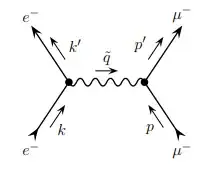It sounds weird, but it's true: for a weak central potential, the differential scattering cross section doesn't care about the sign of the potential! That's what you've shown, and to build intuition, I'll show why it's also true in the more familiar settings of quantum and classical mechanics.
Quantum mechanics
For a weak potential, the first Born approximation tells us that
$$\frac{d\sigma}{d\Omega} = |f(\mathbf{k}_i, \mathbf{k}_f)|^2, \qquad f(\mathbf{k}_i, \mathbf{k}_f) = \tilde{V}(\mathbf{k}_f - \mathbf{k}_i)$$
where $f$ is the scattering amplitude and $\tilde{V}$ is the Fourier transform of the potential. Since $d\sigma/d\Omega$ is proportional to the square of $\tilde{V}$, it doesn't care about its sign. This probably isn't that satisfying, but it at least shows that the phenomenon you've identified is very generic.
Classical mechanics
In the quantum calculations, we are computing scattering amplitudes where the initial state is a plane wave, which is completely delocalized. In the classical theory, this corresponds to shooting an extremely wide beam of test particles at the scatterer, and looking only at the angular distribution of the outgoing particles. Of course, the direction a specific particle is deflected will depend on the potential, but this information is washed out when you average over the beam.
Specifically, suppose the beam is traveling with speed $v$ in the $z$ direction, and consider what happens to the particle which, in the absence of a potential, would have path
$$\mathbf{r}(t) = (x_0, 0, vt), \qquad r(t) = \sqrt{x_0^2 + (vt)^2}.$$
To lowest order in the potential, we can treat the particle's path as unperturbed and compute the impulse it receives,
$$\Delta \mathbf{p} = - \int_{-\infty}^\infty V'(r) \, \hat{\mathbf{r}} \, dt = - \int_{-\infty}^\infty \frac{V'(r(t))}{r(t)} \, (x_0 \hat{\mathbf{x}} + vt \, \hat{\mathbf{z}}) \, dt = - x_0 \int_{-\infty}^\infty \frac{V'(r(t))}{r(t)} \, \hat{\mathbf{x}} \, dt$$
where we dropped a term which was odd in $t$ and thus integrates to zero. The point is that the final impulse, which is proportional to the particle's angular deflection, is proportional to the particle's impact parameter $x_0$, multiplied by a function of $x_0^2$.
Concretely, if we have an attractive potential, then a particle with $x_0 = a > 0$ is deflected towards $- \hat{\mathbf{x}}$, while a particle with $x_0 = -a$ is deflected towards $+ \hat{\mathbf{x}}$. If you flip the sign of the potential, these particles exchange roles. Now it's the particle at $x_0 = a$ that gets deflected towards $+ \hat{\mathbf{x}}$, and vice versa. The differential cross section, averaged over the beam, stays the same.
Discussion
The quantum mechanical derivation is more general than the classical one, because our classical calculation only worked for small deflection angles, while the quantum calculation works for arbitrary deflections. That's because in the classical case, we had to assume the effect of the potential was weak for each particle we considered. By contrast, when a quantum particle scatters, an arbitrarily weak potential can have a large effect on part of the final state, as long as that part of the final state has small amplitude.
It was pointed out in the comments that for the $1/r$ potential, the classical differential cross section is independent of the potential's sign even for large deflections. But this is a red herring, as it's specific to that one potential, while the argument above works for all weak potentials.
The lesson is that the differential cross section is more limited than you might think. Relativistic quantum field theory courses focus on it simply because it's the natural thing you measure in a particle collider. The cross section contains a great deal of information, but often the most basic and intuitive physics is encoded in an opaque way, or not included at all. In my experience, this leads to a lot of confusion when collider physicists try to apply their methods to the rest of physics.
